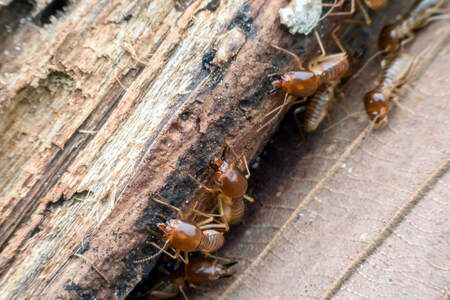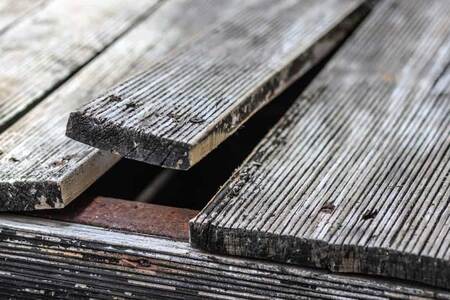
Protecting Your Timber Deck From Termites
Looking for ways to protect your decking from termite colonies? We’ve got you covered with our guide. Final Touch cover everything you need to know about termites and your timber deck.
Read Full StoryA wooden deck can be the perfect solution to enjoy the great outdoors without going outside.
It provides an excellent spot where you can spend time with family and entertain guests, and it can help improve the appearance of your house. However, unlike concrete patios, wooden decks require much maintenance to keep them in good shape, essential for preventing accidents.
This is because the safety of your wooden deck can easily be compromised due to factors like insects, moisture, heat, worn-out hardware, etc. And if adequate steps are not taken to protect the deck, it can result in serious injuries.
Fortunately, there are several ways by which you can ensure your timber deck is in good shape and prevent accidents. And this guide shares some of the most effective ones.
The foundation of a deck comprises support posts and determines the safety and reliability of the deck. To ensure the deck is durable and can provide stable footing, you should confirm the holes for the posts are adequately deep.
Also, check that these holes go below the frost line to prevent the posts from moving in winter, which can happen if the holes are shallow. You can even get the bases of the deck posts encased in galvanised plates to prevent rotting and deterioration that can lead to structural problems.
The railings of a wood deck play a major role in ensuring safety and can be especially useful if you have children. An ideal deck railing should be capable of supporting at least around 90 kg of pressure. You can check whether it is secure by pushing and pulling the railing. Additionally, make sure the distance between the support posts of the railings is at most six feet.
Similarly, the wooden deck railing should be at least three feet high from the deck floor, and the diameter of the handrail should not exceed 2.25 inches. Finally, the distance between the balusters should be at most four inches.

The treads, stringers and risers are responsible for ensuring the stability of the deck stairs. And the safety measures that apply to the deck railings also apply to the guardrails of the stairs. Additionally, you must ensure that there is no wobbling and that the stairs are completely stable.
That is why they must be regularly inspected to ensure they are appropriately attached. It would be best to keep the stairs free of planters, decor and other items that can cause tripping and serious injury.
Wood can get damaged over time due to various factors, such as insects, moisture, heat, etc. To prevent damage by insects like termites, ensure falling leaves, twigs, and other organic matter do not accumulate on the deck. This will also prevent the build-up of mildew and moss, which can make the deck slippery.
If moisture collects on the decking, it can cause splintering and decay. You can use sharp tools like an ice pick and push it into the deck to check whether the surface has become soft. If it has, it is best to get the wood replaced. Inspect the railings, joists, decking boards and other parts as well.

Another thing you should do when undertaking deck maintenance is to take a look at the deck fasteners. Generally, people use screws or nails as fasteners but screws offer a stronger grip on wooden surfaces and do not loosen with time, unlike nails.
However, checking both screws and nails regularly ensures they are not getting loose or corroded. Replace the fasteners that have become loose as soon as possible to prevent wobbling and eliminate creaking noises.
That said, sometimes, you may need a professional to inspect the entire deck and perform repairs.
One of the most important safety precautions you should take is to install adequate lighting on the deck. Besides helping ensure safety, proper lighting will make the deck look more aesthetically pleasing. So, replace light fixtures that are malfunctioning or are damaged, and ensure the various power outlets meet safety standards.
Good lighting is essential on the stairs, and you can even trim the shrubs and other plants around the decking to prevent light blocking.

The wooden decking boards are constantly exposed to the weather, which means they can be affected by elements like sunlight and moisture. Moisture can be especially harmful, leading to slips and mould growth.
Mildew and mould can eat away wooden surfaces like decks, making them unfit. To prevent that from happening, make regular inspections to check for signs of mould and ensure that the deck is cleaned regularly.
It is a good idea to check the underside of your decking, where the ledger board connects it to the house. Ensure the wood and other materials around the ledger board are not damaged or loose. If they are, the chances of the deck collapsing are incredibly high.
So, hire a professional to fix the deck as soon as possible and eliminate the risk of collapse.

The biggest risk to wood decking and deck furniture is fire. Fire hazards can occur when the deck is used for outdoor activities like grilling. To prevent fire damage, make sure to follow certain safety precautions. For instance, when using a grill, ensure a gap of at least two feet between the grill and overhang, sidings, railings and other deck parts.
Keep flammable substances in boxes away from the grill, and consider using a fireproof mat.
A wooden deck at home can improve its value and make the space more enjoyable for your family and friends. Installing such a deck is relatively easy and can be done using DIY methods. However, maintaining such a deck is crucial to ensure that it lasts longer and reduces the chances of accidents.
With the steps mentioned here, it is possible to ensure your deck remains in good condition and provides a great experience. Besides these tips, you should have a maintenance plan that can include regularly inspecting the deck by professionals.
This will help minimise the chances of accidents and ensure the best experience.
Looking for ways to protect your decking from termite colonies? We’ve got you covered with our guide. Final Touch cover everything you need to know about termites and your timber deck.
Read Full StoryWould you like to extend the life of your deck and prevent it from warping? In this guide, you will learn the different types of wood warping and how to avoid them.
Read Full StoryAre you planning to build a brand new pergola in your backyard? Before you begin construction, read our guide for 8 essential things you must consider!
Read Full Story

